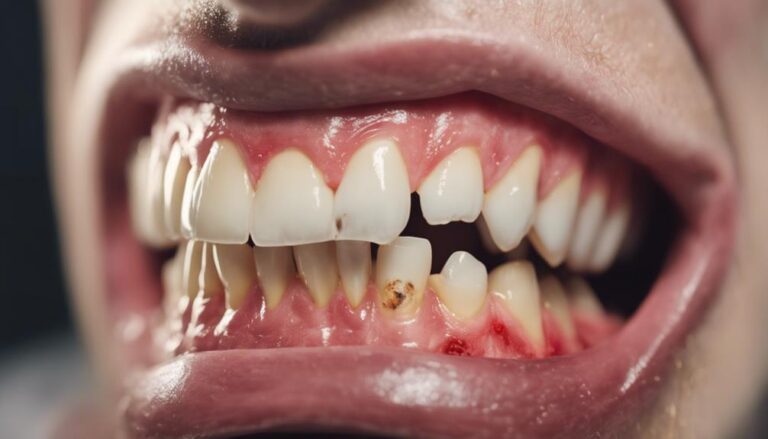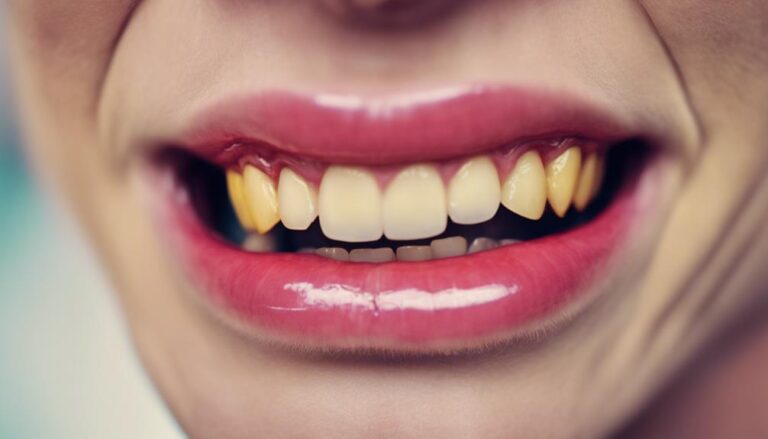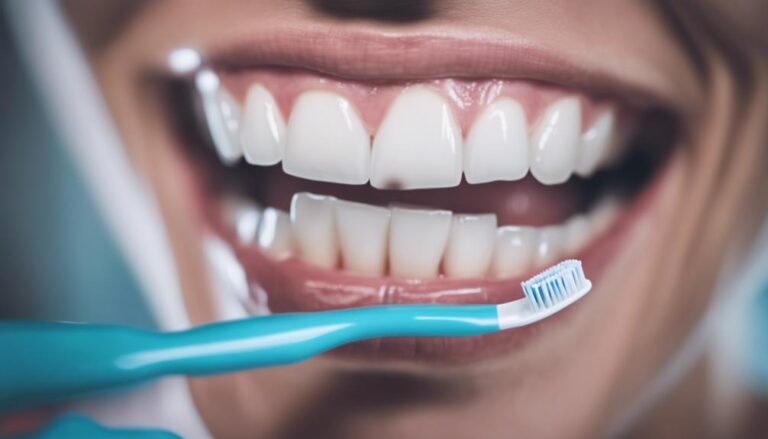To combat bad breath effectively, guarantee proper flossing techniques. Use enough floss and gently slide it between teeth in a ‘C’ shape motion. This removes plaque and food particles that contribute to halitosis. Experiment with tools like water flossers or interdental brushes for added impact. Flossing once a day is vital for maintaining fresh breath. Incorporating these habits into your routine can greatly reduce the risk of gum disease and decay. Your oral health will benefit greatly from these simple yet important flossing practices.
Key Takeaways
- Use a sufficient amount of floss to clean between teeth effectively.
- Glide the floss using a back-and-forth motion in a ‘C’ shape.
- Incorporate flossing into your daily oral hygiene routine.
- Consider using interdental brushes for a more thorough clean.
- Floss at least once a day to remove plaque and prevent bad breath.
Importance of Flossing
Flossing plays an important role in maintaining excellent oral hygiene by removing plaque and food particles that brushing alone may not reach. The benefits of flossing extend beyond just oral health; it contributes to overall health by preventing gum disease and reducing the risk of heart disease and other systemic conditions linked to poor oral hygiene. Proper flossing techniques are vital for effective plaque removal, which is essential for preventing bad breath. When food particles are left between teeth, bacteria break them down, leading to foul odors. By flossing daily, you can greatly reduce the chances of developing bad breath.
Flossing techniques such as the C-shape method or the loop method are particularly effective in reaching areas that a toothbrush can’t access. Incorporating flossing into your daily routine not only enhances your oral health but also contributes to your overall well-being. Consistent flossing is a simple yet powerful way to maintain fresh breath and a healthy smile.
Proper Flossing Frequency
Maintaining ideal oral health involves establishing a consistent routine for plaque removal between teeth. Flossing is an important aspect of this daily routine, offering numerous benefits for oral hygiene. To maximize these benefits, it’s recommended to floss at least once a day. This daily habit helps prevent the build-up of plaque and food particles between teeth, reducing the risk of cavities, gum disease, and bad breath.
Incorporating flossing into your daily oral care regimen is essential for maintaining excellent oral health. By making flossing a part of your daily routine, you ensure that bacteria and debris are effectively removed from areas that a toothbrush can’t reach. This practice promotes healthy gums, prevents tooth decay, and contributes to fresher breath.
Consistency is key when it comes to flossing habits. By establishing a daily flossing routine, you can enjoy the long-term benefits of improved oral hygiene and overall health. So, remember to floss daily to keep your smile bright and your breath fresh.
Correct Flossing Technique
To guarantee effective plaque removal and peak oral health, mastering the correct technique for flossing is essential. Proper flossing techniques not only help in combating bad breath but also contribute to maintaining fresh breath. When flossing, it’s important to use a sufficient amount of floss, around 18 inches, to make sure that you can effectively clean between each tooth without reusing the same section.
Start by wrapping most of the floss around your middle fingers, leaving about 1-2 inches to work with, which allows for a good grip and control during the process. Gently glide the floss between your teeth using a back-and-forth motion, forming a ‘C’ shape around each tooth and moving it up and down to reach below the gumline. Be cautious not to snap or force the floss, as this can injure your gums.
Rinse your mouth after flossing to remove any dislodged plaque or food particles. By following these proper flossing techniques diligently, you can help combat bad breath and maintain excellent oral hygiene.
Flossing Tools for Bad Breath
Regularly incorporating specialized flossing tools into your oral hygiene routine can greatly help in combating bad breath. When it comes to flossing gadgets, effectiveness is key. Here are some popular flossing tools and their results:
| Flossing Tool | Effectiveness |
|---|---|
| Water Flosser | High |
| Air Flosser | Moderate |
| Interdental Brush | High |
| Floss Picks | Moderate |
Water flossers provide a high level of effectiveness by using a stream of water to remove plaque and food particles between teeth. Air flossers, although not as effective as water flossers, still provide a moderate level of cleaning between teeth. Interdental brushes are highly effective in removing debris from larger gaps between teeth. Floss picks offer a moderate level of effectiveness and are convenient for on-the-go use. Experimenting with different flossing tools and techniques can help determine which works best for your oral hygiene needs and combating bad breath.
Benefits of Flossing
Flossing daily promotes excellent oral health by effectively removing plaque and debris from between teeth, contributing to fresher breath and healthier gums. The benefits of flossing extend beyond just preventing bad breath; it plays an essential role in preventing gum disease and tooth decay. By incorporating proper flossing techniques into your daily routine, you can greatly reduce the risk of developing oral health issues.
Consistency in flossing is key to reaping its rewards. Flossing at least once a day helps in removing food particles and plaque that can lead to halitosis, also known as bad breath. This simple habit aids in maintaining good oral hygiene and prevents bacteria from causing gum inflammation or infections. Regular flossing not only cleans areas that a toothbrush can’t reach but also promotes gum health by reducing the risk of gingivitis and periodontal disease. To summarize, the positive impact of flossing on oral health makes it an essential practice for overall well-being.
Flossing and Gum Disease
The link between proper oral hygiene practices, such as flossing, and the prevention of gum disease is well-established in dental research. Maintaining good gum health is vital in preventing conditions like gingivitis and periodontitis. Flossing plays a vital role in this by removing plaque and food particles that can lead to gum inflammation and disease.
To guarantee excellent gum health, it’s important to follow proper flossing techniques. Using about 18 inches of floss and gently sliding it between the teeth in a C shape helps clean the sides of each tooth effectively. Avoid snapping the floss against the gums, as this can cause damage and lead to bleeding, which is a common sign of gum disease.
Flossing mistakes can inadvertently contribute to gum issues, so being mindful of how you floss is crucial. By incorporating flossing into your daily routine and paying attention to flossing tips, you can greatly reduce the risk of gum disease and promote fresher breath by preventing halitosis.
Flossing and Plaque Removal
Effective plaque removal through proper flossing techniques greatly contributes to maintaining excellent oral health and preventing dental issues. When plaque, a sticky film of bacteria, builds up on teeth, it can lead to gum disease and bad breath. By flossing correctly, you can remove plaque from between teeth where toothbrushes can’t reach, helping to prevent these problems.
To guarantee maximum plaque removal, it’s crucial to use the right flossing techniques. When flossing, gently glide the floss between each tooth in a back-and-forth motion, wrapping it into a ‘C’ shape around each tooth to clean below the gumline. Doing this daily helps to break up and remove plaque effectively.
Flossing and Halitosis
Maintaining proper oral hygiene through regular flossing can greatly influence the occurrence of halitosis, commonly known as bad breath. Bad breath prevention is a key reason why flossing should be an integral part of your daily oral care routine. Flossing helps remove food particles and plaque from between your teeth, areas where your toothbrush cannot reach effectively. By eliminating these hidden sources of odor-causing bacteria, flossing benefits not only your oral health but also your confidence in social interactions.
| Benefits of Flossing for Halitosis |
|---|
| Removes food particles |
| Reduces plaque buildup |
| Prevents bacterial growth |
Flossing and Oral Health
Improving oral health through consistent flossing is essential for preventing dental issues and maintaining overall well-being. Flossing benefits extend beyond just fresh breath; it plays an important role in promoting ideal oral hygiene. Here are some key points to keep in mind:
- Plaque Removal: Flossing helps remove plaque from between teeth, where toothbrushes can’t reach effectively.
- Gum Health: Regular flossing reduces the risk of gum disease by eliminating food particles and bacteria that can lead to inflammation.
- Preventing Cavities: By removing debris, flossing decreases the chances of developing cavities in hard-to-reach areas.
- Fresh Breath: Flossing removes trapped food particles that can cause bad breath, contributing to overall oral hygiene.
- Overall Health: Maintaining good oral hygiene through flossing is linked to lower risks of systemic diseases like heart disease and diabetes.
Consistent flossing, in combination with regular dental check-ups, is a cornerstone of a healthy oral care routine that promotes long-term dental wellness.
Flossing and Tongue Cleaning
How can flossing effectively complement tongue cleaning for the best oral health? Tongue scraping is an important step in maintaining excellent oral hygiene. When combined with flossing, it can greatly reduce bad breath by removing bacteria and food particles that contribute to odors. Flossing helps clean between teeth where a toothbrush can’t reach, preventing plaque buildup and reducing the risk of gum disease. Similarly, tongue scraping removes bacteria, dead cells, and debris from the tongue’s surface, further enhancing oral health.
Incorporating both flossing and tongue cleaning into your daily oral hygiene routine can lead to fresher breath and a healthier mouth. Start by flossing at least once a day, preferably before brushing your teeth, to dislodge any trapped food particles and plaque. Follow this up with gentle tongue scraping to remove the buildup on the tongue’s surface. Consistent practice of these habits can promote better overall oral hygiene and help combat bad breath effectively.
Flossing and Food Particles
Regularly flossing helps effectively remove food particles trapped between teeth, promoting excellent oral hygiene and reducing the risk of dental issues. It’s important to understand the impact of food debris on oral health. Here are key points to keep in mind:
- Food debris: Food particles that linger between teeth can lead to bacterial growth, plaque formation, and eventually tooth decay.
- Oral hygiene: Proper flossing techniques are essential for maintaining good oral hygiene and preventing bad breath caused by decaying food particles.
- Flossing tools: Using dental floss or interdental brushes can help reach areas where toothbrushes may not access, ensuring thorough removal of food debris.
- Technique matters: Employing the correct flossing technique, such as a gentle back-and-forth motion and forming a ‘C’ shape around each tooth, is important for effective food particle removal.
- Frequency: Flossing at least once a day, preferably before bedtime, aids in dislodging food particles and maintaining good oral health.
Flossing and Bacteria Removal
To effectively combat bad breath, proper flossing techniques play an important role in removing bacteria from between teeth. Bacteria elimination is essential for maintaining oral health and preventing halitosis. When it comes to flossing methods, incorporating the appropriate techniques can greatly reduce the bacterial load in the mouth, leading to improved breath freshness.
Here is a table highlighting essential flossing techniques for effective bacteria removal:
| Flossing Technique | Description |
|---|---|
| 1. Important Technique | Make sure the floss is gently curved around each tooth in a C shape to reach below the gumline where bacteria hide. |
| 2. Regular Flossing | Floss at least once a day to remove food particles and bacteria that can cause bad breath. |
| 3. Antimicrobial Floss | Consider using floss treated with antimicrobial agents to help reduce bacteria levels in hard-to-reach areas. |
Flossing and Mouthwash
In maintaining excellent oral hygiene, the combination of flossing and mouthwash can greatly enhance the removal of bacteria and promote overall mouth freshness. When used together, these two oral hygiene strategies can provide thorough care for your teeth and gums. Here are some key points to keep in mind:
- Mouthwash benefits: Mouthwash can reach areas in the mouth that may be difficult to access with floss or a toothbrush.
- Reduced plaque buildup: Using mouthwash after flossing can further decrease plaque buildup, which is essential for preventing gum disease.
- Fresh breath: Mouthwash helps in combating bad breath by eliminating bacteria that cause odors in the mouth.
- Added fluoride protection: Some mouthwashes contain fluoride, which can help strengthen tooth enamel and prevent cavities.
- Overall oral health: The combination of flossing and mouthwash can contribute to improved oral health and reduce the risk of dental issues in the long run.
Flossing and Dental Check-ups
For excellent oral health, maintaining a routine of flossing and regular dental check-ups is crucial. Flossing benefits dental hygiene by removing plaque and food particles that brushing alone may miss, thereby reducing the risk of gum disease and cavities. When combined with dental check-ups, flossing becomes even more effective in preventing oral health issues.
Regular dental visits, typically recommended every six months, allow for professional cleaning, identification of early signs of dental problems, and personalized advice on oral care. This frequency guarantees that any developing issues are caught early, reducing the risk of complications and the need for extensive treatments. During these visits, dentists can also educate patients on proper flossing techniques, ensuring they’re maximizing its benefits for cavity prevention.
Flossing Tips for Fresh Breath
Exploring effective flossing techniques not only aids in combatting bad breath but also contributes greatly to overall oral hygiene. When it comes to breath freshening, proper flossing plays an important role in removing food particles and plaque that can lead to unpleasant odors.
Here are some essential flossing tips to help keep your breath fresh:
- Regular Flossing: Make sure to floss at least once a day to remove debris and bacteria from between your teeth.
- Proper Technique: Use a gentle back-and-forth motion to curve the floss around each tooth in a C shape, reaching below the gum line.
- Floss Holders: If traditional flossing is challenging, consider using floss holders or interdental brushes for easier access.
- Mouthwash: After flossing, rinse with an antimicrobial mouthwash to further reduce bacteria and freshen your breath.
- Professional Guidance: Consult your dentist for personalized advice on flossing techniques and products tailored to your oral health needs.
Frequently Asked Questions
Can Flossing Too Vigorously Cause Damage to the Gums?
Flossing too vigorously can indeed harm the gums. It’s important to practice gentle flossing techniques to maintain excellent gum health. Vigorous flossing may lead to gum irritation, bleeding, and potential damage. Consistency and care are key.
Is There a Particular Type of Floss That Works Best for Bad Breath?
I find that using a waxed dental floss helps combat bad breath effectively. Employing proper flossing techniques, like gently gliding the floss between teeth daily, can greatly impact oral hygiene and freshness.
Can Flossing Actually Help Prevent Cavities and Tooth Decay?
Flossing, a key component of oral hygiene, is highly effective in preventing cavities and tooth decay. Research shows that flossing can reduce cavities by up to 80%. Consistent flossing is essential for excellent dental health.
Should Mouthwash Be Used Before or After Flossing for Fresh Breath?
When considering mouthwash usage for fresh breath, it’s crucial to prioritize preventive benefits. I recommend using mouthwash after flossing to enhance its effects. This proper technique guarantees excellent oral hygiene by reaching areas floss might miss.
Can Flossing Alone Completely Eliminate Bad Breath?
In the quest for fresh breath, flossing plays an essential role. While it’s beneficial, flossing alone may not completely eliminate bad breath. Incorporating tongue scraping, mouthwash, water flossers, and regular dental check-ups can enhance oral hygiene and tackle halitosis effectively.
Conclusion
To sum up, flossing is an essential part of oral hygiene that can help combat bad breath.
Did you know that studies have shown that flossing can remove up to 80% of the plaque in hard-to-reach areas between teeth?
By incorporating proper flossing techniques into your daily routine, you can improve your overall oral health and maintain fresh breath.
Remember, a healthy mouth starts with good flossing habits!






